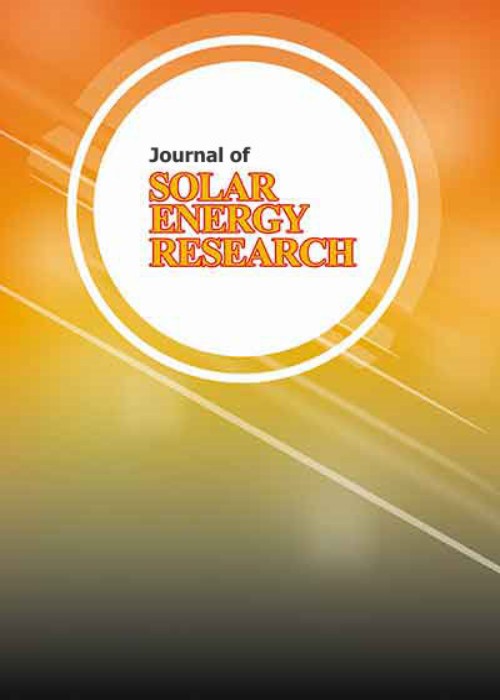فهرست مطالب
Journal of Solar Energy Research
Volume:5 Issue: 1, Winter 2020
- تاریخ انتشار: 1398/11/12
- تعداد عناوین: 6
-
-
Pages 308-313
In recent decades, use of solar systems is developed and it is used in many small applications even in home appliances. DC micro grids with centralized solar generation are widely interested for various power applications due to their advantages over traditional AC power distribution systems with respect to power density and power distribution efficiency. On the other hand, protection of these kind of systems against faults are hard to diagnose. It is difficult to extinguish these arc faults via conventional circuit breakers due to the lack of natural zero-crossing of DC current. To overcome of this problem, this article proposed a new smart relay for detecting and clearing faults in solar networks that can gather data of all elements in grid and transmit data to a central control system in a SCADA system by using IEC61850 standards.
Keywords: SCADA, IED, IEC61850, solar, DC microgrid, Fault Detection -
Pages 314-331Given the importance of optimal consumption of energy in buildings, as one of the major energy consumption parts, a real residential villa was simulated in the hot and dry and also hot and humid climates in this study. The solar irradiation of photovoltaic panels was used for partial supply of energy needs of the building. The proposed strategies to improve the building and reduce its energy consumption included thermal insulators embedded in the walls and the ceiling, and replacement of simple old windows with double glazed windows equipped with temperature sensors and smart interior shadings. In hot and dry climate of Isfahan, implementing solar panels, wall and ceiling insulation, double glazed smart windows, internal smart shading and natural ventilation lead to optimal energy consumption with 38.43 and 50.94% reduction in the cooling and heating loads, respectively. In hot and humid climate of Bandar Abbas, all of mentioned scenarios except natural ventilation were used and showed 46% thermal loads reduction. Solar power could support 67.3% of electricityKeywords: Building energy optimization, Solar energy, Climate, Design Builder
-
Pages 332-340In this study, a new configuration of the solar chimney is introduced and its performance is compared with the conventional one. Using numerical simulation, the effect of different climatic conditions (cold and dry, hot and arid, hot and humid) on the performance of the new solar chimney is studied using the weather information of three cities of Iran including Tabriz (cold and dry), Yazd (hot and arid), and Bandar Abbas (hot and humid). It is found that the new solar chimney has 13-20% better performance than the conventional one, depending on climatic conditions. Also, the results showed that the performance of the new configuration is better in cold and dry climate zone than that in the other zones. Additionally, in this study, a new correlation for the estimation of the mass flow rate of solar chimney is introduced using four non-dimensional parameters.Keywords: Solar chimney, Natural ventilation, climatic conditions, Non-dimensional analysis
-
Pages 341-350
The form, size and orientation of the building are the most important effective parameters on internal climate and have direct effect on thermal performance of the building. The aim of this research is to investigate the amount of received radiation energy of vertical surfaces in buildings and to determine the appropriate form, aspect ratio and orientation of building in accordance with the hot-dry climate in the cities of Isfahan, Semnan, Kashan and Kerman. In this research, six polygonal forms, including square, rectangle with North-South and East-West orientation, hexagonal, octagonal, hexadecagon, and triacontadigon (circle) were studied. All the investigated forms had the same floor area and height, oriented to the South. The aspect ratios of the rectangular form were 1:1.2, 1:1.4, 1:1.6, 1:1.8, 1:2, and the orientation of the optimum aspect ratios were 180º, 165º, 150º, 135º, 120º, 105º SE and SW. Using the “Law of Cosines” computational method, the amount of received radiation energy on vertical surfaces was calculated, for different months and in 32 geographic directions, in terms of the cold and hot periods of the year. The results show that the best forms of the buildings in Isfahan, Semnan, Kashan and Kerman cities is the rectangle with East-West orientation. The most suitable aspect ratio for the EW rectangular form in studied cities is 1:1.6 and the best orientation for the determined aspect ratio is 180º south.
Keywords: Form, aspect ratio, orientation of building, Hot-dry climate, Solar energy -
Pages 351-361In this study, the performance of a 3D curved solar air heater was simulated using fluent software. Then based on the available data an equation is presented to estimate the efficiency of heaters with different curves as well as the corresponding constraints. Increasing the curvature of the heater increases the thermal efficiency, but this is compounded by the cost of building the machine and the pressure drop. The higher the pressure drop the stronger the compressor will require to pump the air to the desired flow rate.Keywords: Solar air heater, Curvature, Heat transfer, Pressure Drop
-
Pages 362-373In this study, the thermodynamic and economical design of an organic Rankine cycle with different energy sources in Arak has been investigated. The effect of organic fluids and pinch temperatures on the Rankine cycle performance was analysed. The use of other energy sources such as solar energy, biomass, heat recovery from micro turbine was Discussed and the cost of power generation was calculated. According to the heat required by the Rankin cycle, the solar tower in Arak has been designed and estimated. The output power of the organic Rankine cycle using microturbine is increased by about 20%The highest cost of power generation is the use of microturbine, solar energy, biomass and hot water, respectively.Keywords: Thermodynamic analysis, Thermal performance, hot water, solar system, micro turbine, fossil, Biomass


